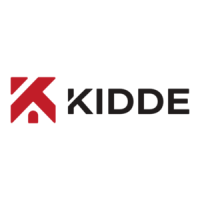General Information
06-237619-001 1-3 April 2020
1-2 FIRE EXTINGUISHMENT METHODS
Fire extinguishing using Kidde IGS can be achieved in the following ways:
• Total Flooding: Release of Agent into an enclosure (Total Flooding) means that the mini-
mum design concentration is created within the entire room volume.
• Dedicated protection: Release of Kidde IGS systems may be executed inside protected
unit(s) (machine/equipment) for example, EDP equipment or electrical cabinets, if it is
deemed to be more appropriate than total flooding of the entire room. It shall, however,
be noted that the turbulences from the discharge nozzle may present a risk to the equip-
ment/electronics within the cabinets etc.
• Selector valve system – Central bank system: If more than one room in a building is to be
protected, a common cylinder bank (central bank) may be used. The capacity of the cylin-
der bank shall be calculated for protection of the largest room together with any adjoining
rooms which may be involved in a fire simultaneously. Selector valve systems can involve
total flooding and dedicated protection.
1-3 SAFETY
The agents used in Kidde IGS do not decompose when extinguishing a fire. As such, the agents
do not produce toxic or corrosive decomposition products as a by-product of the combustion
mechanism. However, heat and breakdown products from the fire itself can still be substantial
and could make the area untenable for human occupancy until the enclosure is properly
vented. Kidde IGS systems are designed to provide a Residual Oxygen Level (ROL) between
10-14% after a discharge.
Following a discharge the residual oxygen concentration will not support combustion of most
fires, but it will allow occupants to breathe normally. Evacuation of the protected room can be
performed in a calm and orderly manner. Occupants should never be encouraged to
intentionally remain in the area during a discharge, even in the event of accidental or test
discharge. The release of the Agent may create considerable turbulence in the enclosure,
causing dust etc. to be mixed in the atmosphere which could cause breathing problems.
1-3.1 Personal Safety
Suitable safeguards shall always be provided to ensure prompt evacuation of and prevent entry
into a hazardous atmosphere and to provide means for prompt rescue of any trapped
personnel. Safety items such as personnel training, warning signs, discharge alarms, self-
contained breathing apparatus, evacuation plans, and fire drills shall be considered and
implemented as required. Consideration shall be given to the possibility of Agent migration into
adjacent areas outside of the protected space (pressure relief, vent openings, and such).
If employees can vacate the area within 3 minutes, Kidde IGS systems may be designed for a
Residual Oxygen Level (ROL) as low as of 10% (sea level equivalent). Where evacuation may
take up to five minutes the system may be designed to have a minimum ROL of 12% (sea level
equivalent).
• LOAEL: 52% equal to 10% ROL, sea level equivalent
• NOAEL: 43% equal to 12% ROL, sea level equivalent
If the ROL could potentially drop to 8-10% (sea level equivalent) employees must be
evacuated prior to introducing this higher degree of oxygen depletion. A design concentration
resulting in a ROL of 8-10% (sea level equivalent) may only be used in normally unoccupied
areas, and even then only if any occupants who could possibly be exposed can vacate the area
within 30 seconds. Pre-warning alarms and evacuation drills shall therefore always be applied
when the necessary design concentration will result in a ROL of 8-10%. For NFPA 2001
designed systems, the following items should be installed:
• Pneumatic Discharge Delay
•Pneumatic Siren
•Lockout Valves
• Proper Signage

